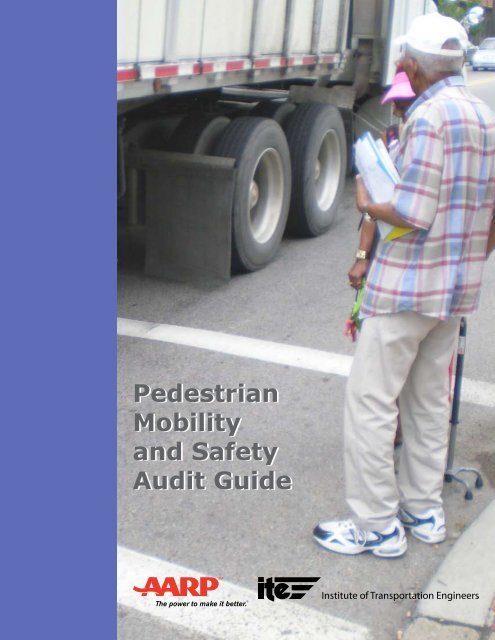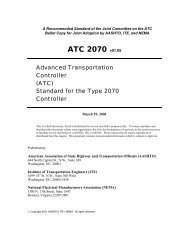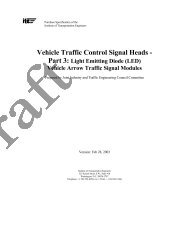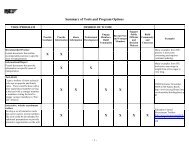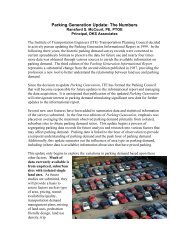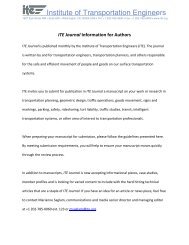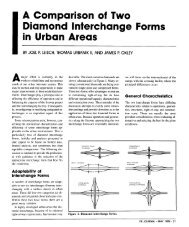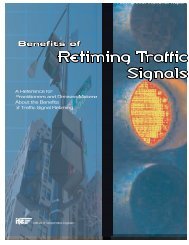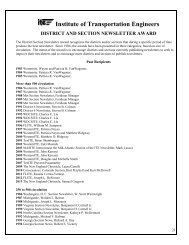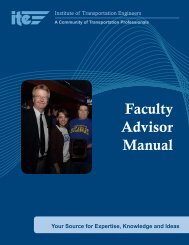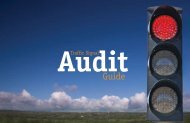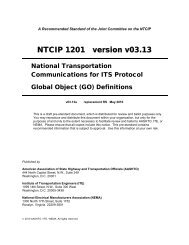Pedestrian Mobility and Safety Audit Guide Pedestrian Mobility and ...
Pedestrian Mobility and Safety Audit Guide Pedestrian Mobility and ...
Pedestrian Mobility and Safety Audit Guide Pedestrian Mobility and ...
Create successful ePaper yourself
Turn your PDF publications into a flip-book with our unique Google optimized e-Paper software.
<strong>Pedestrian</strong><br />
<strong>Mobility</strong><br />
<strong>and</strong> <strong>Safety</strong><br />
<strong>Audit</strong> <strong>Guide</strong>
Table of Contents<br />
Acknowledgments ...............................................................................................1<br />
Introduction ..........................................................................................................5<br />
Institutional/Governmental .................................................................................9<br />
Environment .......................................................................................................13<br />
Traffic/Drivers ....................................................................................................19<br />
<strong>Pedestrian</strong> ..........................................................................................................21<br />
<strong>Pedestrian</strong> Shoulders ............................................................................................................ 21<br />
<strong>Pedestrian</strong> Sidewalks ............................................................................................................ 21<br />
<strong>Pedestrian</strong> Crossings ............................................................................................................ 25<br />
<strong>Pedestrian</strong> Behavior .............................................................................................................. 35<br />
Transit .................................................................................................................37<br />
Bicycles ..............................................................................................................39<br />
Appendix A—<strong>Pedestrian</strong> References ..............................................................41
Acknowledgments<br />
Authors<br />
Edward R. Stollof, Senior Director, <strong>Safety</strong> Programs, Institute of Transportation Engineers<br />
Janet M. Barlow, Certified Orientation <strong>and</strong> <strong>Mobility</strong> Specialist, Access Design for the Blind<br />
Project Team<br />
Gary B. Thomas, Director of the Center for Professional Development at Texas Transportation<br />
Institute, Texas A&M University<br />
Frank Carroll, Senior Project Manager, <strong>Mobility</strong> Options, AARP Driver <strong>Safety</strong> Program &<br />
<strong>Mobility</strong> Options<br />
Elizabeth Bradley, Integrated Communications, AARP<br />
Philip J. Caruso, Deputy Executive Director, Institute of Transportation Engineers<br />
Marianne E. Saglam, Senior Communications Director, Institute of Transportation Engineers<br />
Christina Garneski, Graphics <strong>and</strong> Layout Specialist, Institute of Transportation Engineers<br />
Publications<br />
A number of checklist items used in this guide were extracted from the following<br />
publications:<br />
• Federal Highway Administration (FHWA) publication, <strong>Pedestrian</strong> Road <strong>Safety</strong> <strong>Audit</strong><br />
<strong>Guide</strong>lines <strong>and</strong> Prompt Lists. Final Report. July 2007.<br />
• FHWA: A Resident’s <strong>Guide</strong> for Creating Safe <strong>and</strong> Walkable Communities.<br />
• Easter Seals Project ACTION as part of the Toolkit for the Assessment of Bus Stop<br />
Accessibility <strong>and</strong> <strong>Safety</strong>.<br />
Photos from the <strong>Audit</strong>s<br />
Photo credit: Ed Stollof<br />
1
<strong>Pedestrian</strong> <strong>Mobility</strong> <strong>and</strong> <strong>Safety</strong> <strong>Audit</strong> <strong>Guide</strong><br />
2<br />
Photo credit: Ed Stollof<br />
Photo credit: Ed Stollof
Photo credit: Ed Stollof<br />
Photo credit: Ed Stollof<br />
November 2008<br />
3
Photo credit: Ed Stollof<br />
Photo credit: Ed Stollof
Introduction<br />
The <strong>Pedestrian</strong> <strong>Safety</strong> <strong>and</strong> <strong>Mobility</strong> <strong>Audit</strong> <strong>Guide</strong> can be used as a tool before volunteer auditors<br />
go out into the community. The guide can be used to familiarize volunteers with the myriad<br />
technical, administrative, regulatory, social <strong>and</strong> behavioral issues related to pedestrian safety<br />
<strong>and</strong> mobility at intersections <strong>and</strong> road segments. Figure 1 illustrates the pedestrian safety <strong>and</strong><br />
mobility audit process used by the AARP/ITE volunteer participants. The content of this guide<br />
is reflective of the elements contained within step 1 of the pedestrian safety <strong>and</strong> mobility audit<br />
process.<br />
In the following section each of the major steps of the audit process are briefly reviewed to<br />
provide the reader with a comprehensive underst<strong>and</strong>ing of the process followed by the AARP/<br />
ITE pilot pedestrian safety <strong>and</strong> mobility audit program. Please keep in mind that any of these<br />
steps can be modified <strong>and</strong> tailored to the resources of each locality <strong>and</strong> that AARP <strong>and</strong> ITE<br />
are looking for continuous feedback on processes <strong>and</strong> materials so that refinements may be<br />
made in the future.<br />
FIGURE 1. <strong>Pedestrian</strong> <strong>Safety</strong> <strong>and</strong> <strong>Mobility</strong> <strong>Audit</strong> Process<br />
Step 1: Review <strong>Audit</strong> <strong>Guide</strong><br />
Step 2: Conduct <strong>Audit</strong> Briefing<br />
Step 3: Conduct Field <strong>Audit</strong><br />
Step 4: <strong>Audit</strong> Debriefing<br />
Step 4: Implementation<br />
5
<strong>Pedestrian</strong> <strong>Mobility</strong> <strong>and</strong> <strong>Safety</strong> <strong>Audit</strong> <strong>Guide</strong><br />
6<br />
Step 1: The <strong>Audit</strong> <strong>Guide</strong><br />
This guide is not meant to be used as an exhaustive checklist. Other more extensive <strong>and</strong>/or subject–related<br />
checklists are available from the U.S. Department of Transportation, Federal Highway Administration 1 , Easter<br />
Seals PROJECT ACTION 2 , the University of California Berkeley <strong>and</strong> Institute of Transportation Studies Technology<br />
Transfer Program. A more comprehensive set of references for pedestrian audit guides, prompt lists, checklists<br />
<strong>and</strong> knowledge bases that can assist community volunteers can be found in Appendix A of this document. This<br />
audit guide provides the basis for orientation <strong>and</strong> discussion with audit participants during the audit day briefing<br />
(Step 2).<br />
Feedback from the AARP pilot test volunteers <strong>and</strong> staff indicated that the audit guide needs to be as “nontechnical”<br />
as possible <strong>and</strong> that the photographs are extremely helpful. AARP volunteers <strong>and</strong> staff like the fact<br />
that they were provided with the audit guide in advance of the audit because they had time to study the materials<br />
<strong>and</strong> to review the photographs. As part of the preparation for the pedestrian safety <strong>and</strong> mobility audits, advance<br />
information for the audit locations was provided in terms of maps, digital photographs, traffic counts <strong>and</strong> pedestrian<br />
crashes (if available). The audit participants used the materials in the guide, such as photographs of potentially<br />
good solutions <strong>and</strong> mobility <strong>and</strong> safety obstacles to clarify their thoughts on the issues presented for their own<br />
community on the day of their audit.<br />
This guide is different from other guides developed for governmental or educational organizations in the following<br />
ways:<br />
• The document is as non-technical as possible. A combination of brief questions <strong>and</strong> photographs are<br />
used to illustrate basic knowledge or content areas.<br />
• The document is as short as possible. Many audit guides are more than 100 pages in length; this guide is<br />
just over 40 pages. The need for brevity is balanced with the requirement to provide the reader technical<br />
tools needed for the audit.<br />
• The questions <strong>and</strong> tips associated with each photograph are designed as if the volunteer <strong>and</strong> audit<br />
participant is not “sitting in their living room” while reading this guide, but as if the volunteer/audit<br />
participant is walking along a sidewalk or through an intersection. A realistic picture has been painted so<br />
when participants go into the field they will have a comprehensive underst<strong>and</strong>ing of pedestrian safety <strong>and</strong><br />
mobility issues.<br />
The guide is divided into the following content areas:<br />
• Institutional/Governmental<br />
• Environment<br />
1. A Resident’s <strong>Guide</strong> for Creating Safe <strong>and</strong> Walkable Communities: http://safety.fhwa.dot.gov/PED_BIKE/ped/<br />
ped_walkguide/residentsguide.pdf.<br />
<strong>Pedestrian</strong> Road <strong>Safety</strong> <strong>Audit</strong> <strong>Guide</strong>lines <strong>and</strong> Prompt Lists. FHWA. Final Report. July 2007: http://drusilla.<br />
hsrc.unc.edu/cms/downloads/PedRSA.reduced.pdf.<br />
2. A checklist was developed by Easter Seals PROJECT ACTION as part of the Toolkit for the Assessment of<br />
Bus Stop Accessibility <strong>and</strong> <strong>Safety</strong>. More information can be found at http://projectaction.easterseals.com/site/<br />
PageServer?pagename=ESPA_BusStopToolkit.<br />
3. A Technical <strong>Guide</strong> for Conducting <strong>Pedestrian</strong> <strong>Safety</strong> Assessments for California Cities: http://www.techtransfer.<br />
berkeley.edu/tse/psa_h<strong>and</strong>book.pdf.
• Traffic/Drivers<br />
• <strong>Pedestrian</strong><br />
• Transit<br />
• Bicycles<br />
Step 2: Conduct the <strong>Audit</strong> Briefing<br />
The audit briefing is a classroom-style learning experience designed to provide the volunteer<br />
participants with a reinforcement of knowledge beyond what participants have learned from their<br />
preparation included in the audit guide. Another key element of the audit briefing is to have the<br />
volunteers <strong>and</strong> the professionals talk to one another in a discussion format. AARP volunteers are<br />
able to interact with ITE traffic engineers, local police, city council persons, directors of public<br />
works, transit <strong>and</strong> parking professionals, office of aging staff, metropolitan planning organization<br />
staff, state department of transportation planners, engineers <strong>and</strong> others. The volunteers (1)<br />
underst<strong>and</strong> who to contact for help to solve a transportation-pedestrian problem <strong>and</strong> (2) can begin<br />
to grasp the complexity of the governmental decision-making structure.<br />
The classroom time is approximately one to two hours, depending how the local community<br />
group desires to organize the day. The briefing can include a discussion of (1) logistics of the<br />
day; (2) audit goals (e.g. safety, mobility, accessibility, sustainability/quality-of-life); (3) problem<br />
identification; (4) development of solutions; <strong>and</strong> (5) implementation.<br />
Step 3: Conduct the Field <strong>Audit</strong><br />
Depending upon local needs, the pedestrian audit may consider one or more blocks of sidewalk,<br />
one or more intersections or road sections within a community, or multiple areas within a community.<br />
In terms of lessons learned, regarding time requirements <strong>and</strong> physical dem<strong>and</strong>s, the experience<br />
of the pilot workshops indicated that to adequately address complex intersections that may be<br />
within different areas of a jurisdiction, participants may need to allow 30 to 45 minutes to evaluate<br />
each location. This will allow different teams to address each of the content areas included in the<br />
guide. In the pilot workshops AARP volunteers were paired with ITE transportation engineers or<br />
other traffic or transportation professionals during the field audit. During the field audit the goal<br />
was to identify the problem <strong>and</strong> potential solution development. In a given day the teams were<br />
able to accomplish a maximum of three to five intersection locations before departing back to<br />
the “classroom” for the debriefing session. Keep in mind, the entire audit team conducted a minidebriefing<br />
at the conclusion of the field audit. The participants “huddled together” to discuss the<br />
location findings <strong>and</strong> conclusions prior to traveling to the next location.<br />
Step 4: <strong>Audit</strong> Debriefing<br />
The final step of the audit day is the audit debriefing. The amount of time allotted for this step<br />
is approximately 30 minutes. In this step, the organizers of the audit distributed <strong>and</strong> collected<br />
evaluation forms. In addition, there was a discussion between the volunteers <strong>and</strong> the transportation<br />
professionals regarding how improvements to future workshops could be made. The organizers of<br />
the workshop discussed the extent to which the volunteers gained an appreciation for what to look<br />
for in terms of existing conditions related to problem identification <strong>and</strong> development of solutions.<br />
November 2008<br />
7
Step 5: Implementation<br />
During the implementation phase, there are a number of activities that need to take place including:<br />
• prepare audit report;<br />
• meet with agency representatives;<br />
• contact local transportation engineer with questions regarding potential improvements or issues as<br />
needed; <strong>and</strong><br />
• prioritize, program <strong>and</strong> implement improvements.<br />
Underst<strong>and</strong>ing the requirements of the above activities, the ITE transportation professionals can meet with the<br />
AARP volunteer one-on-one to first identify a problem <strong>and</strong> discuss potential solutions. One very important finding<br />
from the pilot project is that many high-impact pedestrian improvements needed by seniors <strong>and</strong> all users to<br />
make a difference are low-cost <strong>and</strong> can be implemented quickly. Sometimes a traffic engineer can implement an<br />
improvement that may be as simple as painting stripes in a crosswalk to make it more noticeable. Getting to the<br />
right agency representative in a local bureaucracy can sometimes be difficult. ITE transportation professionals<br />
can give guidance in directing individuals to the correct person or can give guidance themselves.
Institutional/Governmental<br />
This section of the guide is a place to note the various people who may be involved in roadway,<br />
sidewalk <strong>and</strong> intersection planning <strong>and</strong> operations. Every city or jurisdiction has slightly<br />
different titles for these individuals; some may serve in two capacities in smaller areas. This<br />
section will provide you with a list of possible contacts, many of whom you may meet during<br />
the audit.<br />
List the key contacts you already know <strong>and</strong> the ones you meet during the pedestrian safety<br />
<strong>and</strong> mobility audit. Also note the key contacts that you do not meet during the audit, but whose<br />
contact information may be useful in the future.<br />
Key Contacts<br />
Engineering/Public Works:<br />
Traffic Engineer:<br />
Planning Staff: Long-Range/Short-Range/Development Review:<br />
Transportation Planner:<br />
Metropolitan Planning Organization (MPO) Transportation Contact:<br />
Local or State Safe Routes to School (SRTS) Coordinator:<br />
Local or State <strong>Pedestrian</strong> Coordinator:<br />
Local or State Bicycle Coordinator:<br />
9
<strong>Pedestrian</strong> <strong>Mobility</strong> <strong>and</strong> <strong>Safety</strong> <strong>Audit</strong> <strong>Guide</strong><br />
10<br />
Local or State <strong>Safety</strong> Organization:<br />
Parking Management/Parking Enforcement:<br />
Transit Administration/Transit Services:<br />
Americans with Disabilities Act (ADA) Coordinator:<br />
Disability Rights/Advocacy Organization:<br />
Department of Aging:<br />
State Department of Transportation (<strong>Pedestrian</strong> <strong>Safety</strong>):<br />
City/County Councilperson Interested in <strong>Pedestrian</strong> <strong>Safety</strong>:<br />
Others:<br />
Key <strong>Pedestrian</strong>-related Laws <strong>and</strong> Penalties<br />
Determine the pedestrian-related laws in your state. If you do not know them, this is something that will be<br />
discussed on the day of the audit (please ask the police officer).<br />
Laws regarding pedestrian behavior <strong>and</strong> right of way as well as driver behavior <strong>and</strong> right of way may be different<br />
at crosswalks with pedestrian signals compared to crosswalks without signals. When signals are present,<br />
pedestrians are required to obey the signals <strong>and</strong> must begin crossing during the WALK signal. When no signals<br />
are present, vehicles may be required to stop or yield for pedestrians only when pedestrians are within the lane<br />
of the roadway.
Who has the right of way at signals, pedestrians or drivers? Under what conditions?<br />
November 2008<br />
Who has the right of way at unsignalized crosswalks, pedestrians or drivers? Under what conditions?<br />
When should vehicles (drivers) yield for pedestrians?<br />
Are there penalties for jaywalking?<br />
Speeding laws<br />
Other laws<br />
Photo credit: Ed Stollof<br />
11
<strong>Pedestrian</strong> <strong>Mobility</strong> <strong>and</strong> <strong>Safety</strong> <strong>Audit</strong> <strong>Guide</strong><br />
12<br />
LAW ENFORCEMENT<br />
What do police <strong>and</strong> law enforcement in your community do to help protect pedestrians? What laws are in place?<br />
What else is needed?<br />
CONTACTS<br />
Chief of Police<br />
Head of Traffic Section<br />
Police Traffic <strong>Safety</strong> Enforcement Officer<br />
Who are the contacts in the department who are interested in pedestrian safety or are working on<br />
pedestrian issues?<br />
What are the police department policies <strong>and</strong> training processes related to enforcement of pedestrian<br />
laws?<br />
What are some ways in which pedestrian concerns can be better addressed?
Environment<br />
Identify locations, intersections <strong>and</strong> road segments you will be auditing:<br />
What are the adjacent l<strong>and</strong> uses?<br />
Who are the primary users of the intersection/street segment?<br />
q Cars/drivers (teens) q <strong>Pedestrian</strong>s (older persons)<br />
q Cars/drivers (middle-aged adults) q Transit/buses<br />
q Cars/drivers (older persons) q Light rail/trolley<br />
q <strong>Pedestrian</strong>s (children) q Taxis/limousines<br />
q <strong>Pedestrian</strong>s (teens) q Bicycles<br />
q <strong>Pedestrian</strong>s (middle-aged adults) q Large trucks<br />
q <strong>Pedestrian</strong>s (women with strollers/babies)<br />
What do you like about the photograph below from an “all user” perspective?<br />
The environment here serves all users well:<br />
• Bicycles (separate on-street bicycle lane)<br />
Photo credit: Ed Stollof<br />
• <strong>Pedestrian</strong>s (wide sidewalks, shade trees, high emphasis crosswalk marking, curb<br />
ramp with truncated dome detectable warnings)<br />
• Transit users (bus stop, shelter)<br />
• Vehicles (parking, travel lanes)<br />
13
<strong>Pedestrian</strong> <strong>Mobility</strong> <strong>and</strong> <strong>Safety</strong> <strong>Audit</strong> <strong>Guide</strong><br />
14<br />
Pleasantness of Walk<br />
• Is the area pleasant for walking with nice buffers from the street <strong>and</strong> manicured lawns?<br />
• Are the sidewalks shaded by trees?<br />
• Are l<strong>and</strong>scaping <strong>and</strong> street furniture (trees, benches, planters, bicycle racks, phone booths <strong>and</strong> hydrants)<br />
placed in a utility/planting strip along the curb outside the line of travel?<br />
• Are there resting places for pedestrians, such as benches or low walls, along the sidewalks?<br />
• Are resting places shaded adequately from the sun?<br />
Personal Security<br />
Do you see any issues related to personal security?<br />
• Run-down/vacant buildings<br />
• Pollution/automobile exhaust<br />
• Graffiti/trash<br />
• Loiterers or suspicious/criminal activity<br />
• Unleashed dogs<br />
• Poor lighting<br />
Maintenance <strong>and</strong> Obstructions<br />
Photo credit: Michael Ronkin Photo credit: Ed Stollof<br />
• Is the sidewalk generally clear of obstructions (no<br />
protruding trees, overhanging foliage)?<br />
• Are there movable or temporary obstructions that<br />
can be addressed through maintenance, policy<br />
<strong>and</strong> enforcement (such as newspaper st<strong>and</strong>s,<br />
parked cars, l<strong>and</strong>scaping, portable signs <strong>and</strong> trash<br />
cans)?<br />
• Is the sidewalk smooth or are there cracks or<br />
uneven surfaces that would present dangers to<br />
pedestrians?<br />
Photo credit: Ed Stollof
Wayfinding<br />
• Are there enough signs to help pedestrians find important destinations?<br />
• Are street names clearly visible?<br />
• Are walking routes clearly signed for pedestrians?<br />
• Do signs convey a simple, clear meaning?<br />
Some locations have<br />
maps that are specifically<br />
designed for pedestrian<br />
wayfinding, such as this<br />
example from Philadelphia<br />
(near right.)<br />
A combination of readable<br />
maps <strong>and</strong> directional<br />
signage helps pedestrians<br />
locate destinations.<br />
The sign on the far right<br />
could be improved by the<br />
addition of information<br />
about the distance to<br />
destinations.<br />
Construction Areas<br />
• Are sidewalks continued through construction areas?<br />
• Are the walkways smooth <strong>and</strong> easy to negotiate?<br />
November 2008<br />
Photo credit: Michael Farrell Photo credit: Michael Farrell<br />
• Are signs clear <strong>and</strong> easy to read? People who are blind may need tactile or audible cues to warn them of<br />
obstructions. Are these cues provided at appropriate locations?<br />
• Do you feel safe walking near construction?<br />
Photo credit: Meg Robertson Photo credit: Barbara McMillen<br />
15
<strong>Pedestrian</strong> <strong>Mobility</strong> <strong>and</strong> <strong>Safety</strong> <strong>Audit</strong> <strong>Guide</strong><br />
16<br />
Here are some examples of pedestrian crosswalk signs. Which signs do you like? Which signs have you<br />
seen in your own communities?<br />
Crossing Distance<br />
• Street crossings should be direct, intuitive <strong>and</strong> as<br />
straight as possible.<br />
• Are there ways to minimize crossing distances<br />
with narrower lanes <strong>and</strong> curb extensions?<br />
Photo credit: Ed Stollof Photo credit: Ed Stollof<br />
Photo credit: Ed Stollof<br />
As shown here, <strong>and</strong> in the picture on the following<br />
page, curb extensions, also called buld-outs, can<br />
be used where on-street parking is provided. This<br />
narrows the crossing <strong>and</strong> makes pedestrians more<br />
visible to drivers.<br />
Photo credit: Michael Ronkin<br />
Photo credit: Michael Ronkin
Sight Distance<br />
Photo credit: Michael Ronkin<br />
November 2008<br />
• Are there objects at the side of the road or in the median that may obstruct sight-lines between approaching<br />
drivers <strong>and</strong> pedestrians beginning to cross the roadway? Objects may include trees <strong>and</strong> other l<strong>and</strong>scaping,<br />
street furniture such as signal cabinets, transit shelters, utility poles <strong>and</strong> snow banks.<br />
• Are there obstructions that would prevent a driver from seeing a child or a person in a wheelchair who are<br />
approaching intersections <strong>and</strong> driveways?<br />
• Are pedestrian crossings located in an area where sight distance may be a problem?<br />
• Can pedestrians see vehicles at all legs of the intersection/crossing <strong>and</strong> vice versa?<br />
Lighting<br />
• Does the sidewalk have adequate lighting? Adequate lighting is especially important on narrow pedestrian<br />
paths, underpasses <strong>and</strong> bridges where nighttime security is an issue. Additional lighting on the sidewalk<br />
is particularly important where trees obscure light from street lights. Commercial sidewalks should be<br />
more brightly lit than streets.<br />
• Are intersections <strong>and</strong> crosswalks well-lit? Intersections (including mid-block crosswalks) should be twice<br />
as bright as the adjacent roadway.<br />
• Are there illuminated signs at night? Do these signs assist pedestrians using the crosswalks?<br />
Photo credit: Michael Ronkin Photo credit: Ed Stollof<br />
17
Traffic/Drivers<br />
Speed <strong>and</strong> Other Driver Behavior<br />
• Is vehicle travel speed a problem for pedestrians? How?<br />
• Are there any traffic devices in the study area to slow down traffic?<br />
• Are any vehicles running red lights?<br />
• Do you observe illegal passing?<br />
• Is there evidence of drunk driving?<br />
• Is there evidence of aggressive driving?<br />
• Is there evidence of distracted driving or cell phone use?<br />
• Is traffic congestion so severe that backed-up traffic is blocking the crosswalks at<br />
signalized/unsignalized crossings or at mid-block crossings?<br />
• Do vehicles that are turning right on green yield to pedestrians in the crosswalk?<br />
• Are drivers who are trying to turn right on red pulling into <strong>and</strong> blocking the<br />
crosswalk?<br />
Photo credit: Janet Barlow<br />
Photo credit: Janet Barlow<br />
19
<strong>Pedestrian</strong><br />
PEDESTRiAn SHOuLDERS<br />
Use of Shoulders as <strong>Pedestrian</strong> Facilities<br />
• Is there a walkable shoulder along the road? Is it wide enough to accommodate cyclists<br />
<strong>and</strong> pedestrians?<br />
• Is the walkable shoulder continuous <strong>and</strong> on both sides of the streets?<br />
• If a walkable shoulder is present, consider the following:<br />
- Is the shoulder wide enough to accommodate pedestrian <strong>and</strong> bicycle<br />
volumes?<br />
- Is the shoulder continuous <strong>and</strong> on both sides of the street?<br />
- Does it provide a link to other pedestrian facilities?<br />
- Is the shoulder adequately maintained (free of mud, severe pavement<br />
deterioration <strong>and</strong> plowed snow)?<br />
- Is the shoulder clearly delineated by clear <strong>and</strong> well-maintained pavement<br />
markings?<br />
PEDESTRiAn SiDEWALKS<br />
Sidewalks<br />
• Are sidewalks provided beside the road?<br />
• Are sidewalks continuous <strong>and</strong> on both sides of the streets?<br />
Photo credit: Michael Ronkin<br />
21
<strong>Pedestrian</strong> <strong>Mobility</strong> <strong>and</strong> <strong>Safety</strong> <strong>Audit</strong> <strong>Guide</strong><br />
22<br />
Lack of sidewalk prevents passage by pedestrians with mobility impairments <strong>and</strong> may be muddy <strong>and</strong><br />
unpleasant for any pedestrian on a rainy day.<br />
• Is the sidewalk width adequate for<br />
pedestrian volumes?<br />
• Is the sidewalk pleasant, with a<br />
l<strong>and</strong>scape strip between the sidewalk<br />
<strong>and</strong> the roadway, or is there a narrow<br />
sidewalk right beside the road?<br />
• Does the sidewalk end abruptly? Is<br />
there a break or missing section in the<br />
sidewalk?<br />
• Do the sidewalks provide at least a 48inch<br />
minimum accessible width (level,<br />
smooth, without poles in the middle)?<br />
Photo credit: Michael Ronkin Photo credit: Ed Stollof<br />
Photo credit: Janet Barlow Photo credit: Michael Ronkin<br />
Remember the<br />
sidewalk shown<br />
on the right (larger<br />
photo on p. 8)?<br />
Would you prefer a<br />
sidewalk that looks<br />
like this or the one<br />
on the left?<br />
Photo credit: Doug Barlow
November 2008<br />
• Are the walking surfaces adequate? For example, do unsafe conditions exist such as uneven surfaces,<br />
tripping hazards, minor uplifts, or lips in the pavement surface? Are the surfaces poorly maintained, with<br />
loose debris, snow, or ice?<br />
• Are sidewalks smooth <strong>and</strong> slip resistant? Does the area use brick <strong>and</strong> bumpy textures? These are not<br />
good walking surfaces. Textures should only be used for edging <strong>and</strong> trim.<br />
• Steep walking surfaces (both running slopes <strong>and</strong> cross slopes) can affect pedestrian stability <strong>and</strong> control,<br />
especially for persons with disabilities. Are sidewalks designed to minimize slopes? Do they provide<br />
intermittent level l<strong>and</strong>ings (places to stop <strong>and</strong> rest)?<br />
Driveways<br />
Photo credit: Janet Barlow<br />
• Does the number of driveways make the route undesirable for pedestrian travel?<br />
• Driveways <strong>and</strong> smaller cross streets should raise to sidewalk level, not vice-versa – think of wheelchair<br />
access <strong>and</strong> going up <strong>and</strong> down at every driveway.<br />
• Are drivers at driveways endangering pedestrians on the sidewalk?<br />
Photo credit: Ed Stollof<br />
This narrow sidewalk on steep uphill slope<br />
would be difficult for pedestrians with disabilities.<br />
It is also on a school walking route.<br />
This photo shows arterial with commercial<br />
driveway entrances <strong>and</strong> exits onto sidewalks<br />
every few feet. Is this the type of environment<br />
that would be a comfoortable walk from an<br />
environmental <strong>and</strong> utilitarian st<strong>and</strong>point? Would<br />
you feel safe walking here?<br />
23
<strong>Pedestrian</strong> <strong>Mobility</strong> <strong>and</strong> <strong>Safety</strong> <strong>Audit</strong> <strong>Guide</strong><br />
24<br />
Signs <strong>and</strong> Other Features<br />
• Are signs worn, missing, or damaged?<br />
• Is the visibility of signs adequate during the day <strong>and</strong> night? If there is poor visibility, what is the issue?<br />
Poor sign visibility may result from damage, v<strong>and</strong>alism, poor maintenance, or obstruction by vegetation<br />
or other structures.<br />
Corners<br />
• Is the waiting area sufficient to accommodate<br />
pedestrians, including those in wheelchairs<br />
or those with strollers, during peak pedestrian<br />
times?<br />
Photo credit: Janet Barlow Photo credit: Janet Barlow<br />
Photo credit: Janet Barlow<br />
Besides the limited waiting space at the<br />
corner shown in this photo, the curb ramps<br />
are too steep <strong>and</strong> drainage is poor (notice the<br />
puddles at the base of the curb ramps.)<br />
Are there other maintenance issues, such as the<br />
exposed wires shown in the photo on the left?<br />
Photo credit: Michael Ronkin
November 2008<br />
• When pedestrian crossing is prohibited, are pedestrians directed to better crossings with physical barriers,<br />
such as fencing, barriers, bollards, shrubs <strong>and</strong> signs?<br />
PEDESTRiAn CROSSinGS<br />
Photo credit: Ed Stollof<br />
Photo credit: Doug Barlow<br />
Narrow clearance, a slippery manhole cover <strong>and</strong> elevation changes of the sidewalk pictured on the right<br />
could cause tripping. Buses extending into sidewalk could also impede movement of people walking, using<br />
wheelchairs, or crutches. The changin slopes could cause balance difficulties.<br />
• Do steep grades (either perpendicular or parallel to crossings) cause problems for pedestrians, especially<br />
those in wheelchairs?<br />
• Do curb ramps on isl<strong>and</strong>s or other refuge areas line up with each other?<br />
• If a raised median or isl<strong>and</strong> is present, is it accessible for all pedestrians? Does it have curb ramps or cutthroughs<br />
of an appropriate width for wheelchair users, with enough room to wait? Does it have detectable<br />
warnings so blind users can detect the median? Are there pushbuttons on the median to call the WALK<br />
signal?<br />
Photo credit: Janet Barlow Photo credit: Ed Stollof<br />
25
<strong>Pedestrian</strong> <strong>Mobility</strong> <strong>and</strong> <strong>Safety</strong> <strong>Audit</strong> <strong>Guide</strong><br />
26<br />
Crosswalk Markings<br />
• Is paint on stop bars <strong>and</strong> crosswalks worn?<br />
• Is the visibility of pavement markings adequate during the day <strong>and</strong> night?<br />
• Are marked crosswalks wide enough?<br />
• Are the walking surfaces in the crosswalks smooth <strong>and</strong> slip resistant? Does the area use brick <strong>and</strong> bumpy<br />
textures? Are the crosswalk markings slippery?<br />
• Are crossings free from puddles, holes, cracks <strong>and</strong> other discontinuities in the pavement that could trip<br />
pedestrians or snag wheelchairs?<br />
• Are the crosswalk markings of the high-visibility type, either ladder or continental style? (Ladder type<br />
markings are shown in the photo above <strong>and</strong> can be easier for people with low vision to see <strong>and</strong> use).<br />
Photo credit: Ed Stollof Photo credit: Ed Stollof<br />
In the photo on the right, does the crosswalk location <strong>and</strong> direction appear to be the desired line connecting<br />
the adjacent l<strong>and</strong> uses?<br />
Look at the photos of crosswalks.<br />
Do you see obstacles that might present themselves for wheelchair users, two persons walking side-by-side, or<br />
a person who is blind or visually impaired?<br />
Photo credit: Ed Stollof Photo credit: Janet Barlow
November 2008<br />
• How would the median isl<strong>and</strong> affect a person using a wheelchair, or someone who has difficulty with<br />
stepping up on a curb?<br />
• Are there pedestrian signals here?<br />
• Is there a curb ramp on the other side of the street?<br />
• Is the sidewalk wide enough? Does the sidewalk seating block the passageway?<br />
• Does the crossing on the right look easy to use?<br />
• Is the pavement smooth?<br />
• Are the markings clear?<br />
• Is there a curb ramp?<br />
• Are there pedestrian signals?<br />
• Can you see <strong>and</strong> use the signal for vehicles?<br />
Look at the photographs below. Would you feel safe walking from one side of the street to the other?<br />
Why or why not?<br />
Photo credit: Lukas Franck Photo credit: Ed Stollof Photo credit:Janet Barlow<br />
Curb Ramps<br />
• Do all crosswalks have curb ramps to provide a transition from the sidewalk to the roadway?<br />
• Look at the curb ramps at the intersection. Are there separate curb ramps for each crossing? There<br />
should not be a single diagonal ramp unless intersection angle is very acute.<br />
• Are the curb ramps aligned with the crosswalk? Why do you think this would be a good idea?<br />
• Is there a flush transition at the gutter so pedestrians who are walking or using wheelchairs are not<br />
tripped or stopped by a lip or curb?<br />
• Is there adequate drainage at the gutter of each curb ramp so water, dirt <strong>and</strong> gravel do not accumulate at<br />
the base of the ramp?<br />
• Does each curb ramp have a level l<strong>and</strong>ing at the top?<br />
• Are truncated dome detectable warning surfaces provided on curb ramps? Detectable warnings should<br />
be installed wherever there is a flush transition between street <strong>and</strong> sidewalk, such as at base of curb<br />
ramps, the cut-through on a median or isl<strong>and</strong>, raised crosswalks, or raised intersections. The strips<br />
should be 24-inches wide <strong>and</strong> extend the width of the flush area.<br />
27
<strong>Pedestrian</strong> <strong>Mobility</strong> <strong>and</strong> <strong>Safety</strong> <strong>Audit</strong> <strong>Guide</strong><br />
28<br />
Look at the photographs below <strong>and</strong> on the next page. What is wrong with these pictures?<br />
Photo credit: Michael Ronkin<br />
Photo credit: PEDS<br />
Photo credit: U.S. Access Board<br />
Vertical curb prevents passage on opposite side of<br />
the street.<br />
New curb ramp on one side of the street.<br />
What might be some other concerns or issues here?<br />
• No crosswalk markings<br />
• No detectable warnings<br />
The br<strong>and</strong> new ramp in this photois not usable by a<br />
person in a wheelchair due to the lip.<br />
Note the photo of curb ramps aligned with the<br />
crossing direction, with a shared level l<strong>and</strong>ing at top of<br />
the ramps.<br />
There may be more of a lip on this ramp than is<br />
desirable.
Photo credit: Ed Stollof<br />
Photo credit: Janet Barlow<br />
Photo credit: Janet Barlow<br />
This photo shows a built-up curb ramp <strong>and</strong> is a<br />
design that is not usually recommended.<br />
What are some of the possible problems with this<br />
design?<br />
• Obstacle for vehicles<br />
• People tripping on edges<br />
• Potential drainage problems<br />
Is the drain at the base of the ramp a problem?<br />
November 2008<br />
The lack of level l<strong>and</strong>ing at the top of the curb<br />
ramp in the photo results in unevenness <strong>and</strong> an<br />
unacceptable cross slope on the sidewalk. This could<br />
cause a loss of traction <strong>and</strong> tripping for wheelchair<br />
users.<br />
The detectable warning surface is installed along the<br />
area level with the street.<br />
Detectable warnings at curb ramps help blind pedestrians<br />
<strong>and</strong> those with limited vision find the edge of the street,<br />
signaling them to stop. The required surface is the bumpy<br />
domed surface shown in this photo; other textures are not<br />
detectable. The color of the detectable warning should<br />
contrast with the sidewalk, either light on dark or dark on light.<br />
What are some other concerns or issues in this photo?<br />
• Uneven surface of the street<br />
• People tripping on edges<br />
29
<strong>Pedestrian</strong> <strong>Mobility</strong> <strong>and</strong> <strong>Safety</strong> <strong>Audit</strong> <strong>Guide</strong><br />
30<br />
<strong>Pedestrian</strong> Signals<br />
• Are there pedestrian signals at the intersection?<br />
• Do pedestrian signals provide adequate time for slower pedestrians to cross the street without feeling<br />
rushed?<br />
• Are the pedestrian signals easy to see? Are they within the crosswalk area?<br />
• Do signals count down the flashing DON’T WALK time? Do you think that is helpful?<br />
• If there are no pedestrian signals, can pedestrians see the vehicle signal? Does it provide adequate time<br />
for a pedestrian to cross the street?<br />
• Are the pedestrian signals audible?<br />
• Is there a sign posted explaining the pedestrian signals <strong>and</strong> pushbuttons?<br />
Photo credit: Todd Brooks Photo credit: Todd Brooks<br />
Photo credit: Ed Stollof<br />
The photo on the left shows an older type of<br />
audible signal (cuckoo/cheep) mounted on<br />
pedestrian signal head. Newer signal types<br />
provide sound from pushbutton.
November 2008<br />
Here are some examples of signs used with pedestrian signals. Do you think one is any better than the<br />
other? Are they underst<strong>and</strong>able? Why or Why not?<br />
Photo credit: Ed Stollof Photo credit: Janet Barlow<br />
Photo credit: Janet Barlow Photo credit: Ed Stollof<br />
31
<strong>Pedestrian</strong> <strong>Mobility</strong> <strong>and</strong> <strong>Safety</strong> <strong>Audit</strong> <strong>Guide</strong><br />
32<br />
<strong>Pedestrian</strong> Pushbuttons<br />
• Do pedestrian signals have pushbuttons?<br />
• Can you tell which crosswalk the pushbutton is for?<br />
• Are the pushbuttons close to the crosswalk?<br />
• Is there a level maneuvering space beside each pushbutton? A level area is needed to allow wheelchair<br />
users to let go of the wheels in order to push the button <strong>and</strong> maintain their balance.<br />
• Are accessible pedestrian signals (APS) provided? New types of signals, called pushbutton-integrated<br />
APS, have new features <strong>and</strong> are helpful to all pedestrians.<br />
• Are APS pushbuttons provided in a location that is easy to reach from the crosswalk <strong>and</strong> in line with the<br />
crosswalk that the pushbutton controls?<br />
Photo credit: Janet Barlow<br />
Photo credit: Doug Barlow<br />
These two pushbuttons have signs that tell<br />
you the name of the street they control, but<br />
there are no street signs.<br />
Pushbuttons <strong>and</strong> their signs should be aligned<br />
with the crosswalk they serve.<br />
These pushbuttons are on a pole in the<br />
grass more than 15 ft. from the corner <strong>and</strong><br />
cannot be reached by individuals with mobility<br />
impairments.<br />
They are also impossible to find for blind<br />
pedestrians <strong>and</strong> those with limited vision.
Photo credit: Janet Barlow<br />
In the photo on the right, not the pushbuttonintegrated<br />
APS on pole. The speaker is a part<br />
of the pushbutton unit, which has a large tactile<br />
arrow with good visual contrasat. The arrow<br />
should be aligned with the crosswalk lines.<br />
The audible walk indication comes from<br />
speakers at the pushbutton <strong>and</strong> may be a rapid<br />
ticking sound or a speech message saying the<br />
street name <strong>and</strong> “walk sign is on.”<br />
There is a pushbutton locator tone, a beep or<br />
a click that comes from the pushbutton once<br />
per second, to help blind pedestrians find the<br />
pushbutton.<br />
In the photo on the left, a curb ramp was<br />
provided at the pushbutton, but without a<br />
level maneuvering <strong>and</strong> turning space, the<br />
pushbutton is not usable by a person in a<br />
wheelchair or with a balance problem.<br />
November 2008<br />
Photo credit: Janet Barlow<br />
33
<strong>Pedestrian</strong> <strong>Mobility</strong> <strong>and</strong> <strong>Safety</strong> <strong>Audit</strong> <strong>Guide</strong><br />
34<br />
<strong>Pedestrian</strong> Crossing Time<br />
• When you take time measurements at various crosswalks, how long did it take pedestrians to cross the<br />
street (indicate name of street being crossed)?<br />
Street No. of Seconds<br />
Street No. of Seconds<br />
Street No. of Seconds<br />
Street No. of Seconds<br />
• How long was the flashing DON’T WALK(the flashing orange h<strong>and</strong>) signal?<br />
Street No. of Seconds<br />
Street No. of Seconds<br />
Street No. of Seconds<br />
Street No. of Seconds<br />
• If there is a pedestrian signal, what is the signal usually when pedestrians finish crossing the street?<br />
q Flashing DON’T WALK<br />
q Steady DON’T WALK<br />
q Other<br />
• If there is a median present, are pedestrian pushbuttons located on the median?<br />
• Are APS available on the median (see photos of accessible pedestrian signals on page 27)?<br />
Unsignalized Crosswalks<br />
Unsignalized crosswalks may be located mid-block or<br />
at an intersection. They may or may not be marked<br />
with crosswalk lines. In most states, a legal crosswalk<br />
exists between two corners of an intersection even<br />
when it is not marked.<br />
• Is it necessary to cross more than two lanes of<br />
traffic without a refuge (an isl<strong>and</strong> or safe place<br />
to wait)?<br />
• Are there sufficient gaps in the traffic for a<br />
pedestrian to cross all the way to the other side<br />
or to the refuge?<br />
Photo credit: Janet Barlow
November 2008<br />
• Is the distance from the stop line (or yield line) to a crosswalk sufficient for drivers to see pedestrians?<br />
• At mid-block crossings, are driveways placed between the stop bar <strong>and</strong> pedestrian crossing?<br />
PEDESTRiAn BEHAViOR<br />
Crossing Roads<br />
Vehicles in adjacent lanes<br />
may obstruct drivers’ view of<br />
pedestrians in the crosswalk.<br />
A yield or stop line that is<br />
set back from the crosswalk<br />
can encourage drivers to<br />
stop further back where both<br />
drivers can see pedestrians<br />
crossing.<br />
• Do pedestrians cross the road without<br />
looking?<br />
• Do pedestrians cross the road at unsafe<br />
locations?<br />
• Generally, do pedestrians walk or run across<br />
the road?<br />
• Do any of the pedestrians appear intoxicated<br />
or under the influence of a substance? If yes,<br />
please explain.<br />
• Do entertainment items such as cell phones <strong>and</strong><br />
iPods distract pedestrians? Are pedestrians<br />
wearing headphones crossing intersections?<br />
• Do pedestrians regularly misuse or ignore<br />
Photo credit: Ed Stollof<br />
pedestrian facilities?<br />
• Do the pedestrians generally hesitate or abort<br />
the crossings?<br />
• Do you observe the pedestrians or vehicle collide? Do they have to stop or maneuver to avoid a<br />
collision?<br />
35
<strong>Pedestrian</strong> <strong>Mobility</strong> <strong>and</strong> <strong>Safety</strong> <strong>Audit</strong> <strong>Guide</strong><br />
36<br />
What solution might you propose to mitigate the pedestrian crossing issues shown in the photographs<br />
below?<br />
What are the issues?<br />
• Wide street<br />
• Long way between crossings (intersections)<br />
• Destinations on opposite sides of the street<br />
What are some possible solutions?<br />
• Medians<br />
• Less lanes<br />
• <strong>Pedestrian</strong> crossing signal/HAWK<br />
Photo credit: Ed Stollof Photo credit: Ed Stollof
Transit<br />
Bus Stops<br />
• Are bus stops clearly marked?<br />
Do signs provide any route<br />
or schedule information?<br />
• Are there sidewalks or<br />
pathways to easily access<br />
the bus stop?<br />
• Are there safe crossings to<br />
access the bus stop?<br />
• Do pedestrians near the<br />
bus stop take risks such as<br />
crossing the street in front of<br />
the bus or running across the<br />
street to catch a bus?<br />
Bus Shelters<br />
• Is there adequate seating?<br />
• Are sidewalks blocked near<br />
bus shelters?<br />
• Is the bus shelter waiting<br />
area <strong>and</strong> seating area at<br />
a safe <strong>and</strong> comfortable<br />
distance from vehicle <strong>and</strong><br />
bicycle lanes?<br />
• Can you easily get to the<br />
shelter from the sidewalk<br />
(or to the sidewalk from the<br />
shelter or the bus stop)?<br />
Is the path cluttered <strong>and</strong><br />
narrow or blocked by signs,<br />
trees, or trash cans?<br />
Photo credit: Janet Barlow<br />
Photo credit: Ed Stollof<br />
Bus Stops <strong>and</strong> Shelters<br />
A l<strong>and</strong>ing area is the area for wheelchair lift to deploy or “l<strong>and</strong>” <strong>and</strong> for people to get<br />
on <strong>and</strong> off the bus.<br />
• Is there a l<strong>and</strong>ing area of at least 5-feet wide <strong>and</strong> 8-feet deep?<br />
• Is the l<strong>and</strong>ing area paved <strong>and</strong> free of problems such as uneven surfaces, st<strong>and</strong>ing<br />
water <strong>and</strong> steep slopes?<br />
• Are there any obstacles that would limit the mobility of a wheelchair (trash receptacle,<br />
newspaper boxes, l<strong>and</strong>scaping, etc.) on the l<strong>and</strong>ing area?<br />
37
<strong>Pedestrian</strong> <strong>Mobility</strong> <strong>and</strong> <strong>Safety</strong> <strong>Audit</strong> <strong>Guide</strong><br />
38<br />
Location<br />
• Where is the bus stop in relation to the nearest intersection?<br />
• Is there a companion bus stop across the street?<br />
• Does the bus stop <strong>and</strong> the surrounding area have sufficient lighting?<br />
Traffic issues<br />
Photo credit: Ed Stollof Photo credit: Ed Stollof<br />
• What is the posted speed limit of the roadway in miles per hour?<br />
• Where does the bus stop or pull off to stop? Is it stopping in the travel lane or is there a parking lane or<br />
separate bus pull off area?<br />
• What are the traffic controls at the nearest intersection to the bus stop?<br />
• Is there on-street parking permitted just before or after the bus stop zone?<br />
• What are potential traffic hazards in the vicinity of the bus stop or pull off area?<br />
Photo credit: Ed Stollof<br />
The photo on the left shows an older type of<br />
audible signal (cuckoo/cheep) mounted on<br />
pedestrian signal head. Newer signal types<br />
provide sound from pushbutton.
Bicycles<br />
• Do you observe people riding bicycles on roadways?<br />
• Do you observe people riding bicycles on sidewalks?<br />
• Are there on-road bicycle lanes?<br />
• Are shoulders marked for bicycle use?<br />
• Are there separate bicycle signals?<br />
Photo credit: Ed Stollof Photo credit: Ed Stollof<br />
Photo credit: Ed Stollof Photo credit: Ed Stollof<br />
39
Appendix A—<strong>Pedestrian</strong> References<br />
“3.11: <strong>Pedestrian</strong> <strong>Safety</strong> <strong>and</strong> Accessibility <strong>Audit</strong> Tools,” Traffic <strong>and</strong> Road Use Management<br />
Manual, Volume 3, Queensl<strong>and</strong> Government, Department of Main Roads, March 24, 2005,<br />
available online at http://www.mainroads.qld.gov.au/MRWEB/Prod/Content.nsf<br />
AASHTO <strong>Guide</strong> for the Planning, Design, <strong>and</strong> Operation of <strong>Pedestrian</strong> Facilities<br />
https://bookstore.transportation.org/item_details.aspx?id=119<br />
ADA Accessibility <strong>Guide</strong>lines (ADAAG)<br />
http://www.access-board.gov/adaag/html/adaag.htm<br />
A <strong>Guide</strong> for Reducing Collisions Involving <strong>Pedestrian</strong>s (NCHRP Report 500)<br />
http://onlinepubs.trb.org/onlinepubs/nchrp/nchrp_rpt_500v10.pdf<br />
How to Develop a <strong>Pedestrian</strong> <strong>Safety</strong> Action Plan (FHWA-SA-05-12)<br />
http://www.walkinginfo.org/pp/howtoguide2006.pdf<br />
Improving <strong>Pedestrian</strong> <strong>Safety</strong> at Unsignalized Crossings (NCHRP Report 562)<br />
http://onlinepubs.trb.org/onlinepubs/nchrp/nchrp_rpt_562.pdf<br />
National Center for Safe Routes to School<br />
http://www.saferoutesinfo.org/<br />
<strong>Pedestrian</strong> <strong>and</strong> Bicycle Crash Analysis Tool (PBCAT)<br />
http://www.bicyclinginfo.org/bc/pbcat.cfm<br />
<strong>Pedestrian</strong> <strong>and</strong> Bicycle Information Center<br />
http://www.walkinginfo.org/<br />
<strong>Pedestrian</strong> Road <strong>Safety</strong> <strong>Audit</strong> <strong>Guide</strong>lines <strong>and</strong> Prompt Lists<br />
http://drusilla.hsrc.unc.edu/cms/downloads/PedRSA.reduced.pdf<br />
PEDSAFE: The <strong>Pedestrian</strong> <strong>Safety</strong> <strong>Guide</strong> <strong>and</strong> Countermeasure Selection System (FHWA-SA-04-003)<br />
http://www.walkinginfo.org/pedsafe/<br />
Public Rights of Way Design <strong>Guide</strong>. Checklist for Accessible Sidewalks <strong>and</strong> Street Crossings<br />
Purpose: Provide st<strong>and</strong>ards for accessible rights of way. U.S. Access Board <strong>and</strong> Federal<br />
Highway Administration.<br />
http://www.access-board.gov/prowac/guide/PROW<strong>Guide</strong>.htm<br />
Road <strong>Safety</strong> <strong>Audit</strong>s: Case Studies (FHWA-SA-06-17)<br />
http://safety.fhwa.dot.gov/rsa/rsa_cstudies.htm<br />
<strong>Safety</strong> Effects of Marked Versus Unmarked Crosswalks at Uncontrolled Locations (HRT-04-100)<br />
http://www.thrc.gov/safety/pubs/04100/index.htm<br />
A Technical <strong>Guide</strong> for Conducting <strong>Pedestrian</strong> <strong>Safety</strong> Assessments for California Cities<br />
http://www.techtransfer.berkeley.edu/tse/psa_h<strong>and</strong>book.pdf<br />
41


